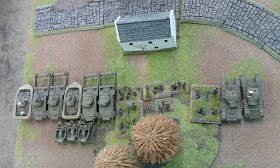Today I review the recently released Battlefront Tank Destroyer Platoon box.
 |
| Cover box art (from flamesofwar.com) |
The Tank Destroyer box contains enough frames to make 4 M10s, 4 M36s or 4 M10C or any combination of the three. There are 2 frames for each vehicle packed with all the pieces needed to make the three different options. The frames also contain a few pieces of stowage - spare track, spare wheels, crates and Jerry cans. Finally, the box contains a crew frame for each vehicle with 6 figures each and a sheet of decals.
I have chosen to make mine up as the M10C. Post war, this vehicle was named the Achilles.
History:
The M10 was a US made tank destroyer, based on the chassis of the Sherman. Unlike the Sherman, the M10 had slopped and thinner armour. This lighter weight design allowed the vehicle to travel quickly. the vehicle was armed with a 3 inch gun and a 0.50 caliber machine gun.
 |
| Achilles crossing a river on a Churchill ARK |
From 1943, M10s were supplied to the British. The British converted some 1100 to the more powerful 17 pound gun. The British employed both 17lb and 3 inch gun versions. The Achilles was used in a rapid deployment anti-tank role. Some Achilles were sent ashore on D-Day.
 |
| Achilles |
Review:
First up, this is one of the new Battlefront plastic kits. I was initially guilty of lamenting the end of the old resin and metal box sets. However, I have changed my tune. The new plastics are great. Best of all, they keep improving. Not just the detail but the extras (stowage), versatility (3 models in one box) and the fit. Yes, there is more construction but I think the result is a better looking vehicle.
 |
Tank Destroyer frames with crew and details at top.
|
The back of the box shows what bits belong to which model. This makes it very simple to work out what is required. The flames of war
website contains a very simple set of assembly instructions.
 |
| The back of the box. (from flamesofwar.com) |
Assembly was pretty straightforward. There are some very nice features to this kit. Firstly most of the mould lines and frame attachment areas end up unseen. BF have done a good job with this. You don't need to necessarily clean up every point, just the ones that are visible. Secondly the barrels and mantlets all have different connections. This means that you cannot attach the wrong gun to a mantlet.
My only real gripe with assembly was the 50 cal MG. The barrel is really fine and hard to clip from the frame without bending or breaking. Eventually I worked out to simply remove the frame from around the MG rather than clipping the MG out.
I think this kit is terrific for the US Tank destroyers. Sadly for the British TD, the crew are not in the kit. According to the BF article, these need to be ordered seperatly. For someone with an existing British force, you will likely have some spare crew from your spares box, however for someone starting out, you will need to buy four of these if you want to model the vehicle with crew. Likewise with decals, these are US focused. Yes, there is a common air recognition symbol but no British-specific decals. For someone looking to make an Achilles, it is still a good kit, there is simply just more work and possibly expense involved
As is the new BF standard, this box doesn't come with magnets. Instead the turret pins are modeled onto each frame. I have only just started trying these so I have yet to form an opinion on them. I will say though that they are easier to apply than the magnets.
Look out for an upcoming painting post. I hope you enjoyed this review.



















































